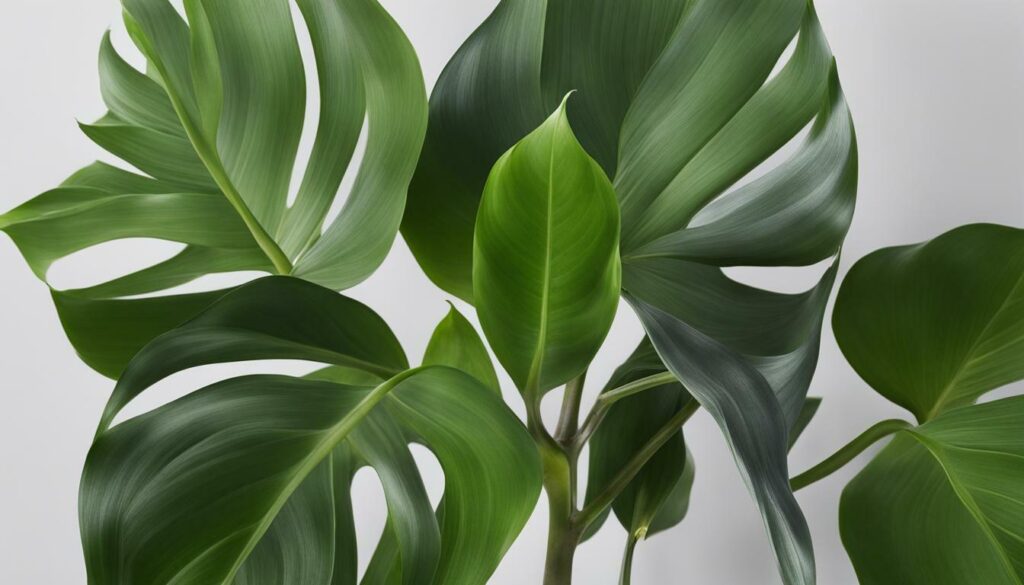–>
Philodendron Silver Sword, also known as Philodendron hastatum, is a captivating houseplant with unique foliage that will add a touch of elegance to any indoor space. This rare indoor plant, native to South America’s rainforests, has gained popularity among plant enthusiasts for its striking silver-green arrow-shaped leaves.
<!–
Key Takeaways
–>- The Philodendron Silver Sword, or Philodendron hastatum, is a rare indoor plant with captivating foliage.
- It requires bright, indirect light and an airy soil mix that retains moisture but drains well.
- Regular watering is necessary, allowing the top inch of soil to dry slightly between waterings.
- The plant thrives in warm temperatures and medium to high humidity.
- During the active growing period, it benefits from regular fertilization and organic-rich soil.
Table of Contents
ToggleIntroduction to Philodendron Silver Sword
Philodendron Silver Sword, scientifically known as Philodendron hastatum, originates from the lush rainforests of South America and has gained a reputation for its striking silvery green arrow-shaped leaves. This unique foliage is what makes it a favorite among indoor gardening enthusiasts. The plant’s elegant appearance adds a touch of tropical beauty to any room, making it a popular choice for plant collectors.
As a climbing plant, the Philodendron Silver Sword requires proper care and attention to thrive indoors. Understanding its origins, appearance, and popularity will help you appreciate the beauty of this plant and provide it with the care it needs.
Origins and Appearance
The Philodendron Silver Sword is native to the tropical rainforests of South America. Its arrow-shaped leaves have a silvery green color, giving the plant a distinctive and eye-catching look. The leaves can grow up to 12 inches long, creating a visually stunning display.
Indoor gardeners are drawn to the Philodendron Silver Sword not only for its unique foliage but also for its ease of care and adaptability to different environments. Its ability to thrive in moderate to high humidity levels makes it suitable for indoor cultivation in various regions.
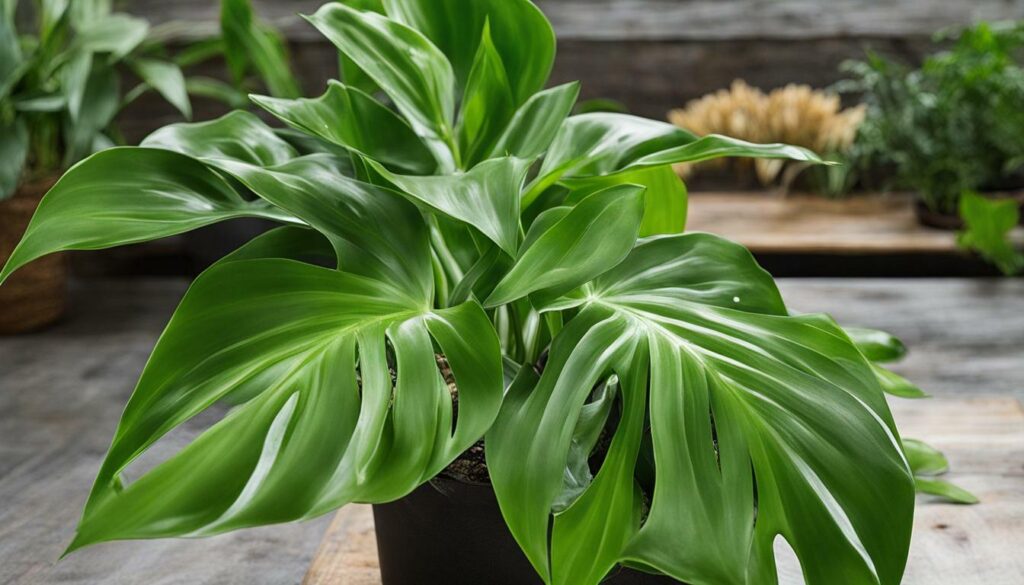
Whether placed in a hanging basket or allowed to climb up a moss pole, the Philodendron Silver Sword adds a touch of elegance to any indoor space. Its striking appearance and relatively low-maintenance requirements make it a favorite among plant enthusiasts.
Light Requirements for Philodendron Silver Sword
Philodendron Silver Sword thrives in bright, indirect light, making it an excellent choice for indoor spaces with lower light levels. The plant’s stunning silvery green leaves not only add a touch of elegance to your home but also adapt well to environments that receive minimal sunlight.
When placing your Philodendron Silver Sword, aim to provide it with sufficient light without exposing it to direct sunlight, as this can scorch the delicate foliage. A north or east-facing window is usually ideal, as it offers bright, indirect light throughout the day. If natural light is limited in your home, you can also use artificial grow lights to ensure your plant receives the necessary light energy.
It’s important to note that insufficient light can lead to leggy growth and a lack of vibrant foliage. If you notice your Philodendron Silver Sword stretching for light or its leaves becoming dull, it may be an indication that it needs more light. On the other hand, if the leaves start to yellow or burn, it may be receiving too much direct sunlight.
Creating the Perfect Light Environment
To optimize the light conditions for your Philodendron Silver Sword, you can consider a few additional measures:
- Rotate your plant periodically to ensure even light distribution and balanced growth.
- Use sheer curtains or blinds to filter intense sunlight and prevent leaf damage.
- If using artificial grow lights, place them at an appropriate distance from the plant to mimic natural light levels.
By carefully monitoring and adjusting the light conditions, you can help your Philodendron Silver Sword flourish and showcase its captivating foliage.
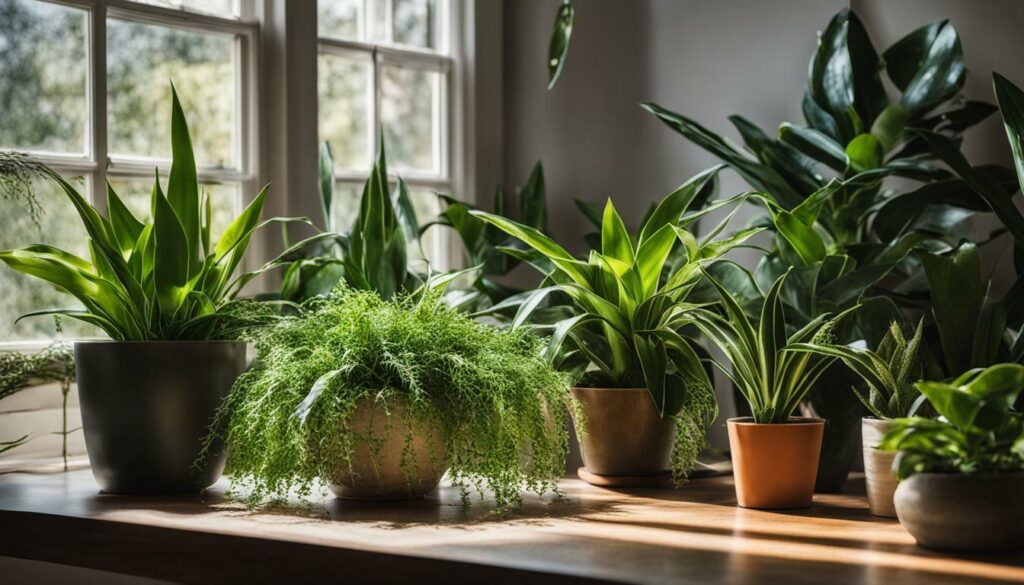
To ensure proper growth, the Philodendron Silver Sword requires an airy soil mix that retains some moisture while also allowing for excellent drainage. This tropical plant prefers a well-draining soil that keeps the roots hydrated without becoming waterlogged. A mixture of peat moss, perlite, and quality potting soil provides the perfect balance of moisture retention and drainage.
When it comes to watering, it’s important to find the right balance. Overwatering can lead to root rot, while underwatering can cause the leaves to droop and the plant to suffer. The Silver Sword Philodendron benefits from regular watering, allowing the top inch of soil to dry slightly before watering again. It’s always a good idea to check the moisture level by inserting your finger into the soil.
During the growing season, the Philodendron Silver Sword thrives with frequent watering. However, it’s important not to let the plant sit in standing water for extended periods. To prevent waterlogging, ensure that the pot has drainage holes and that excess water can freely escape. Watering from the bottom of the pot can also help prevent water accumulation.
Remember, each plant is unique, and factors such as temperature, humidity, and pot size can influence the watering needs of your Philodendron Silver Sword. The best approach is to observe your plant closely, adjust your watering routine accordingly, and strive to maintain a healthy balance of moisture in the soil.
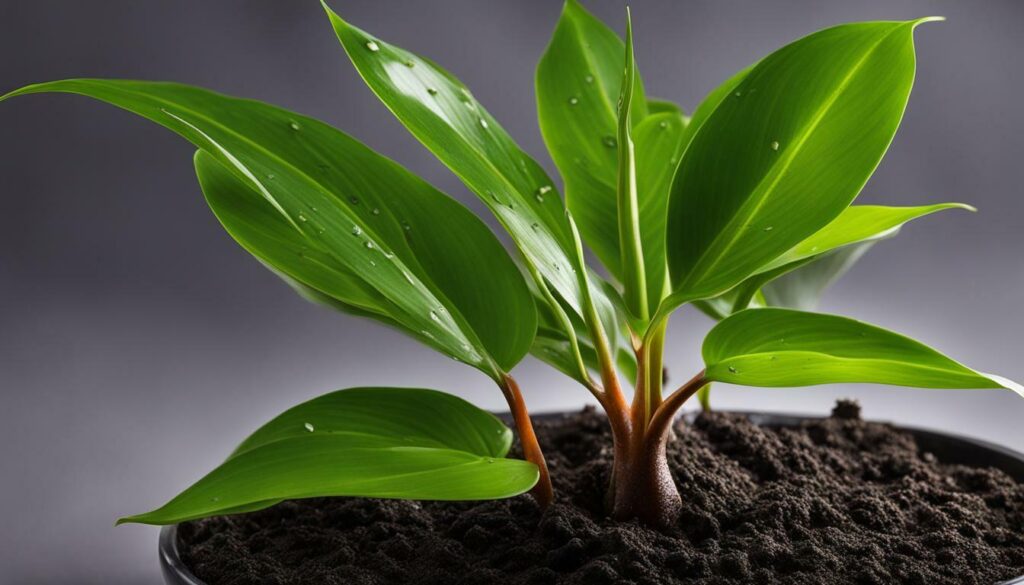
| Soil Requirements | Watering Tips |
|---|---|
| Airy soil mix | Water when the top inch of soil is slightly dry |
| Retains moisture but drains well | Avoid overwatering and waterlogging |
| Peat moss, perlite, and potting soil | Check the moisture level by inserting a finger into the soil |
| Well-draining pot with drainage holes | Water from the bottom to prevent water accumulation |
Temperature and Humidity for Philodendron Silver Sword
The Philodendron Silver Sword thrives in warm temperatures between 65°F and 80°F (18°C to 27°C) and appreciates medium to high humidity levels. Creating the right environment for this tropical plant is essential for its overall growth and vitality.
When it comes to temperature, the Philodendron Silver Sword prefers a warm and consistent climate. Avoid exposing the plant to temperatures below 60°F (15°C) as it may suffer damage or become stunted in growth. A temperature range between 65°F and 80°F (18°C to 27°C) is ideal, mimicking the warm climate of its natural habitat. Placing the plant away from drafts and cold air-conditioning vents will help maintain steady temperatures.
In terms of humidity, the Philodendron Silver Sword enjoys a higher level of moisture in the air. Aim for a humidity range of 50% to 70% to create a comfortable environment for the plant. If the air in your home tends to be dry, especially during the winter months, consider using a humidifier or placing a tray of water near the plant to increase humidity levels. Misting the leaves with water regularly can also provide some moisture. Just be cautious not to overdo it, as excessively wet foliage can lead to fungal issues.

- Monstera deliciosa
- Calathea
- Ficus elastica
- Bird’s Nest Fern
| Tropical Plant | Temperature Range (°F) | Ideal Humidity Level (%) |
|---|---|---|
| Philodendron Silver Sword | 65-80 | 50-70 |
| Monstera deliciosa | 65-85 | 60-80 |
| Calathea | 60-75 | 50-70 |
| Ficus elastica | 65-85 | 40-60 |
| Bird’s Nest Fern | 60-75 | 60-80 |
“The Philodendron Silver Sword thrives in warm temperatures and appreciates higher humidity levels. Creating a suitable environment is key to maintaining its health and appearance.” – Plant Enthusiast
Fertilization and Propagation of Philodendron Silver Sword
Regular fertilization during the active growing period will provide the necessary nutrients for your Philodendron Silver Sword to develop lush foliage. Opt for a balanced liquid fertilizer with equal amounts of nitrogen, phosphorus, and potassium. Dilute the fertilizer according to the manufacturer’s instructions and apply it every four to six weeks. Be sure to water your plant thoroughly after fertilizing to prevent any potential root burn.
Propagation is a great way to expand your Philodendron Silver Sword collection or share the plant with fellow plant collectors. The most common method of propagation is through stem cuttings. Select a healthy stem with at least two to three leaves and make a clean cut just below a node. Remove any lower leaves to allow for root growth, and dip the cut end in a rooting hormone. Place the cutting in a well-draining potting mix, keeping it slightly moist. Provide warmth and indirect light, and within a few weeks, you should notice new roots forming.
Once established, your new plant can be treated as a mature Philodendron Silver Sword. Remember to repot it every one to two years, using a slightly larger pot with fresh potting mix. This will allow the roots to expand and provide fresh nutrients for continued growth. Pruning can also be done during repotting to remove any diseased or damaged leaves and encourage bushier growth. Regularly check for pests and diseases to prevent any spread to your newly propagated plant.
Propagation Process Summary:
- Select a healthy stem cutting with 2-3 leaves.
- Make a clean cut just below a node.
- Remove lower leaves and dip the cut end in rooting hormone.
- Place the cutting in well-draining potting mix and keep it slightly moist.
- Provide warmth, indirect light, and regular care.
- Monitor for new root growth and repot once established.
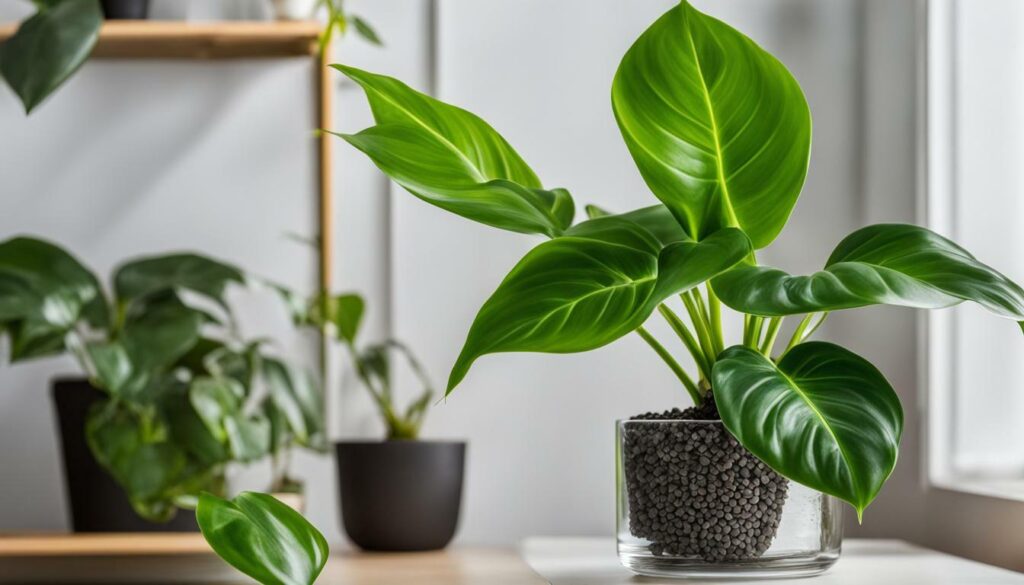
| Pros of Fertilization and Propagation: | Cons of Fertilization and Propagation: |
|---|---|
|
|
Repotting and Pruning Philodendron Silver Sword
Repotting your Philodendron Silver Sword every one to two years will ensure it has enough space for root growth and prevent it from becoming root-bound. This process is best done in the spring or early summer when the plant is actively growing. Choose a slightly larger pot with drainage holes to provide adequate airflow and prevent waterlogged roots. Fill the bottom of the new pot with a layer of fresh, well-draining soil mix.
Gently remove the plant from its current pot, being careful not to damage the roots. If the roots have wrapped tightly around the root ball, gently loosen them to promote new growth. Place the plant in the center of the new pot, making sure it sits at the same depth as before. Fill in the gaps with additional soil mix, pressing lightly to secure the plant.
After repotting, water the Philodendron Silver Sword thoroughly to help settle the soil. Keep the plant in a shaded area for a few days to allow it to adjust to its new home. Once the roots have settled, you can resume your regular watering and care routine.
To maintain the health and appearance of your Philodendron Silver Sword, pruning is essential. Regular pruning helps remove dead or damaged leaves, encourages new growth, and keeps the plant compact and bushy. Use clean, sharp pruning shears to make clean cuts just above a leaf node or stem junction.
When pruning, look for any leaves that are discolored, yellowing, or wilted. These are usually signs of a nutrient deficiency or overwatering. Additionally, trim any stems or vines that have grown excessively long or leggy to promote a more balanced and aesthetically pleasing plant shape.
Remember to clean your pruning tools before and after each use to prevent the spread of pests or diseases. Wipe the blades with rubbing alcohol or a solution of bleach and water to ensure they are sanitized.
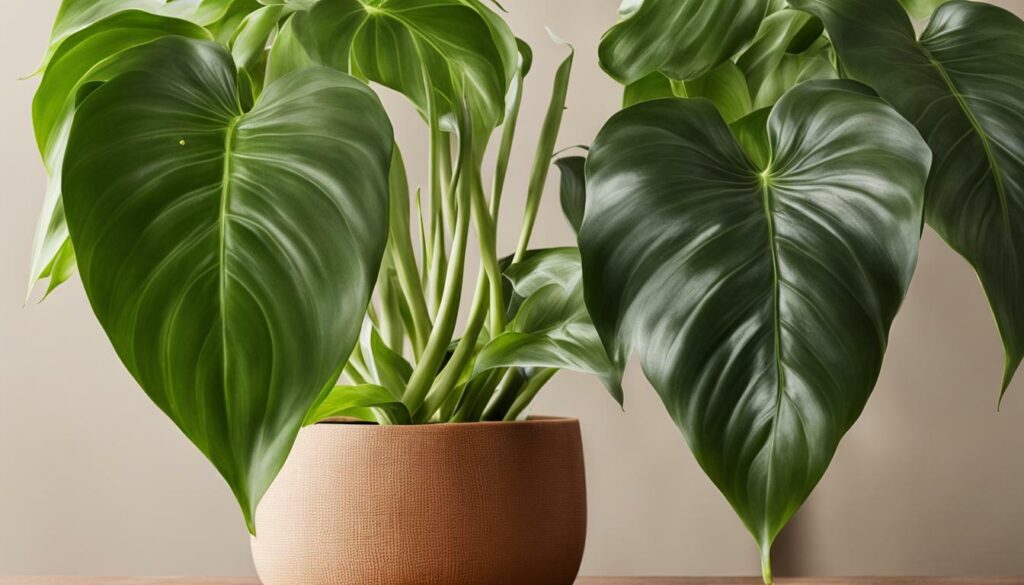
| Benefits of Repotting and Pruning | Tips for Successful Repotting |
|---|---|
|
|
Common Pests and Diseases of Philodendron Silver Sword
While the Philodendron Silver Sword is generally a resilient plant, it can still fall victim to pests like mealybugs, scale, thrips, as well as diseases such as bacterial leaf spot. These issues can affect the plant’s appearance and overall health if not properly addressed.
Mealybugs are small, white, cottony insects that feed on the plant’s sap, causing yellowing leaves and stunted growth. Scale insects attach themselves to the leaves and stems, forming a protective shell that can be difficult to remove. This can lead to leaf discoloration and wilting. Thrips are tiny pests that feed on the plant’s leaves, leaving behind silvery streaks and causing leaf curling. Bacterial leaf spot is a common disease characterized by dark, water-soaked spots on the foliage, which can spread and result in leaf drop if left untreated.
To combat these pests and diseases, it is important to regularly inspect your Philodendron Silver Sword for any signs of infestation or damage. If you spot any pests, you can use an insecticidal soap or a neem oil spray to control their population. For bacterial leaf spot, it is recommended to remove and discard the infected leaves to prevent the spread of the disease.
Preventive measures such as maintaining good air circulation around the plant, avoiding overwatering, and regularly cleaning the leaves can also help minimize the risk of pest and disease problems. Remember to isolate any new plants before introducing them to your collection to avoid potential contamination.
| Pests | Diseases |
|---|---|
| Mealybugs | Bacterial Leaf Spot |
| Scale Insects | |
| Thrips |
By being proactive in pest and disease management, you can ensure that your Philodendron Silver Sword remains healthy and vibrant, thriving as a beautiful addition to your indoor plant collection.
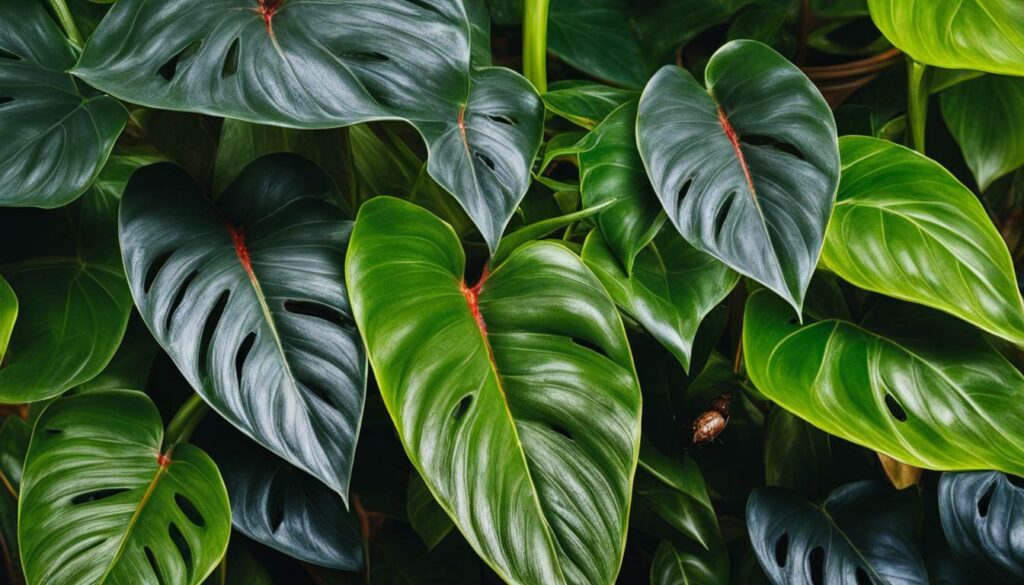
While the Philodendron Silver Sword is undoubtedly an eye-catching plant, it’s crucial to be aware of its toxicity and take necessary precautions to prevent accidental ingestion. The plant contains calcium oxalate crystals, which can cause irritation and discomfort if ingested by both pets and humans.
If you have curious pets or small children at home, it’s essential to keep the Philodendron Silver Sword out of their reach. Place it on high shelves or use hanging planters to ensure it remains inaccessible. It’s also advisable to educate family members about the potential risks and discourage them from handling or consuming any part of the plant.
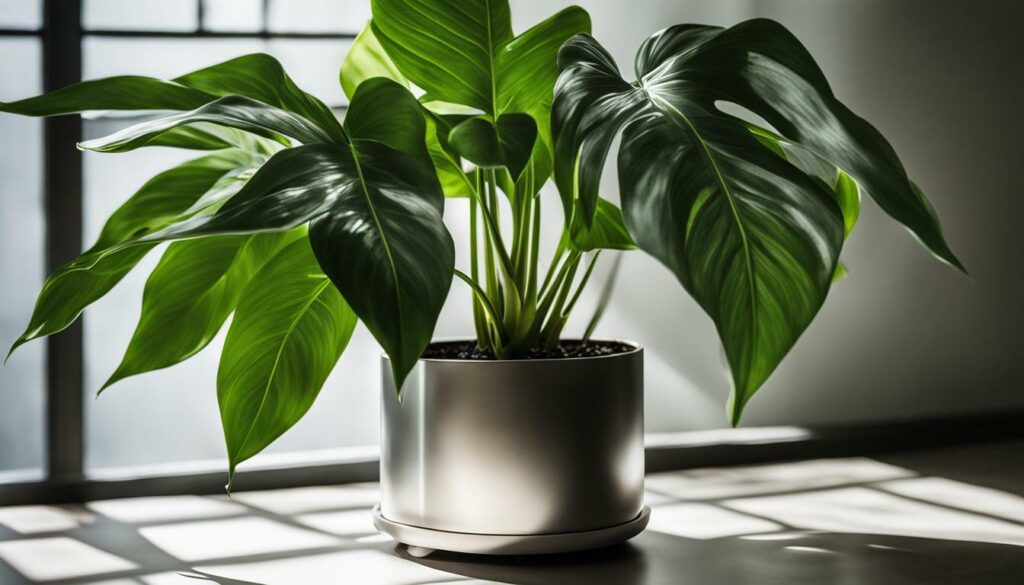
| Symptoms of Philodendron Silver Sword toxicity | Treatment |
|---|---|
|
|
Remember, prevention is key when it comes to protecting your loved ones and pets from the potential hazards of the Philodendron Silver Sword. By practicing responsible plant care and taking the necessary precautions, you can enjoy the beauty of this plant without any worries.
Additional Safety Tips
To further ensure the safety of your household, consider the following:
- Avoid placing the plant near dining areas or locations where accidental ingestion may occur
- Wash your hands thoroughly after handling the Philodendron Silver Sword
- Use gloves when working with the plant to minimize skin contact
- If you suspect your pet has ingested any part of the plant or is displaying symptoms of toxicity, contact your veterinarian immediately
By prioritizing safety and following these precautions, you can confidently enjoy the presence of the Philodendron Silver Sword in your indoor garden.
Conclusion
Philodendron Silver Sword, with its silvery green arrow-shaped leaves, brings a touch of elegance and a tropical feel to any room, making it a must-have for plant enthusiasts and collectors alike. This stunning houseplant from South America’s rainforests has gained popularity among indoor gardeners due to its unique foliage and relatively easy care requirements.
To keep your Philodendron Silver Sword thriving, it’s important to provide it with bright, indirect light and a well-draining yet slightly moist soil mix. Regular watering, allowing the top inch of soil to dry slightly between waterings, will ensure optimal hydration for this tropical beauty. Additionally, maintaining warm temperatures and medium to high humidity levels will promote its overall growth and vitality.
During the active growing period, fertilizing your Philodendron Silver Sword with a balanced fertilizer and using an organic-rich soil mix will help it flourish. You can also propagate new plants from existing ones by taking stem cuttings. Remember to repot your plant every one to two years to ensure its continued health and vigor.
While caring for your Philodendron Silver Sword, be vigilant for common pests like mealybugs, scale, and thrips, as well as diseases like bacterial leaf spot. Prompt treatment and prevention measures will help keep your plant in optimal condition. Lastly, it’s essential to note that the Philodendron Silver Sword is toxic if ingested, so take necessary precautions to keep it out of the reach of pets and children.
FAQ
How often should I water the Philodendron Silver Sword?
The Philodendron Silver Sword should be watered well, allowing the top inch of soil to dry slightly between waterings.
What kind of light does the Philodendron Silver Sword need?
The Philodendron Silver Sword requires bright, indirect light.
How often should I fertilize my Philodendron Silver Sword?
During the active growing period, the Philodendron Silver Sword benefits from regular fertilization.
How do I propagate a Philodendron Silver Sword?
The Philodendron Silver Sword can be propagated through stem cuttings.
When should I repot my Philodendron Silver Sword?
The Philodendron Silver Sword should be repotted every one to two years.
What are common pests and diseases that the Philodendron Silver Sword is susceptible to?
Common pests and diseases to watch out for include mealybugs, scale, thrips, and bacterial leaf spot.
Is the Philodendron Silver Sword toxic to pets and humans?
Yes, the Philodendron Silver Sword is toxic to both pets and humans if ingested.
